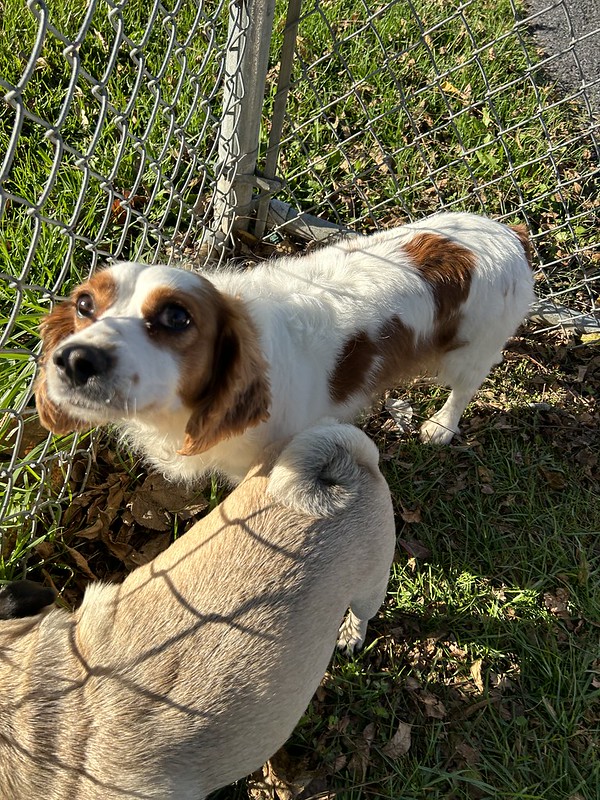What Are Some Effective Training Techniques for Fearful Dogs?
 Coping with abnormal levels of fear in your dog can be a challenging journey for both you and your pup. Although you’ll likely never be able to change your dog’s personality entirely, the right training can make a world of difference in helping them feel more confident, comfortable, and at ease. Today we’ll discuss some unique concepts and techniques you can use when training your fearful pup.
Coping with abnormal levels of fear in your dog can be a challenging journey for both you and your pup. Although you’ll likely never be able to change your dog’s personality entirely, the right training can make a world of difference in helping them feel more confident, comfortable, and at ease. Today we’ll discuss some unique concepts and techniques you can use when training your fearful pup.
Why Is My Dog Scared of Everything?
Before we dive into how to train a hesitant or fearful dog, it’s helpful to understand why your pup may be fearful. Some signs of fear in your dog may be obvious, such as shaking, shying away from interactions with new people or animals, cowering, or even running away — but even aggressive behaviors like lunging or growling are often surface-level reactions to fear. Instead of backing off or avoiding a trigger, these dogs revert to “offensive mode” as a way to scare off the thing causing fear.
A slew of factors play into why a dog develops fearful, anxious, or guarded behaviors. A history of trauma or lack of socialization (with other dogs, pets, and people) can cause a dog to develop a more-fearful personality. Just like us humans, chronic stress and anxiety can also exacerbate fearfulness in dogs. Such stress may come from various environmental factors, such as loud noises, harsh living conditions, or frequent changes in their surroundings.
Things to Keep In Mind When Training a Fearful Dog
Training a fearful or aggressive dog requires a unique and empathetic approach, so here are a few concepts you’ll want to keep in mind when training them:
Create A Safe Space
When training a fearful dog, it’s important to do so in a safe and calm environment. Having a secure space to practice in will help minimize your dog’s stress levels, helping them to relax and put down their guard. This also helps build a sense of trust between them and their owner and trainer, signaling they can rely on their human companion for protection and safety. Ultimately, the benefits of a safe space will help your dog gradually build confidence as they grow more comfortable in their surroundings—this confidence will carry over (at least in part) when they enter new settings.
When curating a safe space, be sure to minimize potential fear triggers, which will help keep them focused and at ease during training. You may also consider incorporating gradual controlled exposure to overwhelming or triggering stimuli to help them to learn how to cope (and ideally redefine) their fears. As your pup builds confidence, gradually expand their comfort zone beyond this safe space as you train.
Structure Is Key
As stress and anxiety can exacerbate fear-driven reactions in dogs, working to reduce stressful triggers in your dog’s life can do wonders for their confidence and comfort levels. Instilling structure in their life can help reduce these triggers. By eliminating surprises and building a sense of predictability into their day-to-day life, they are more likely to be at ease.
One great way you can incorporate structure is through establishing a routine—try your best to feed, walk, and train them around the same time each day. If your dog is especially more fearful, timid, or aggressive in public settings or on walks, add structure to your outings. You can do this by enforcing clear expectations for their leash manners, using commands and positive reinforcement throughout the walk, and encouraging them to focus on the task at hand. This structure helps instill a sense of predictability that can help reduce stress and anxiety.
Be Patient
The importance of patience and understanding when training a fearful dog can not be overstated. Fear, anxiety, and aggressive behavior can be deeply ingrained into your pup. Potentially years of trauma, stress, and isolation have been compounded to create a foundation for fearful behavior—know that it will not be easily dismantled and fixed. Changing your pup’s inclination towards fear requires a process of healing the underlying cause and slowly building a new foundation of trust and safety. This will empower them to slowly build more confidence and adjust to new situations.
This process can take time, so make sure not to rush it and allow your dog to set the pace. Failing to give your pup the time it needs to heal can backfire, leading to more stress and setbacks. Be gentle, supportive, and lead with empathy.
Overview of Effective Training Techniques for Fearful Dogs
Here’s an overview of some helpful techniques you can use to help your dog build confidence and trust, which will not only help them excel in their general training but also help improve their overall behavior.
Desensitization and Counterconditioning
Desensitization and counterconditioning are two training techniques that are often used hand in hand to change a dog’s aggressive or fearful behavior. Desensitization is the process of exposing your dog to a stimulus—specifically one that typically causes unease—very gradually, starting off at a very low intensity. Counter conditioning means training your dog to display a different behavior when interacting with a specific stimulus other than their default.
For example, let’s say your dog is scared of thunderstorms and often has an extreme reaction to thunder and lightning. To counter condition this reaction, you can slowly desensitize them to thunder by gradually exposing them to a simulated storm situation. You can plan a soft recording of thunder while giving them positive attention and treats, which will help reframe the experience of a storm into one that feels less negative and threatening.
Redirection
Redirection is a technique used in dog training to move your dog’s attention away from a fear-triggering stimulus or situation and refocus it on a positive interaction, such as a calming activity or command.
For example, let’s say your dog tends to exhibit fearful and aggressive behavior towards other dogs on walks. Next time you are out of the house with your pup, you can use the redirecting technique to change their behavior when you encounter another pup on your walk—as you notice another dog is coming near, have your dog perform a simple command, such as “sit”. Keep their attention on you while the dog passes and reward them with praise and a treat. In this scenario, you redirect their attention away from the stressful stimuli to a positive interaction, which helps them to associate the presence of another dog with rewards and positive interactions. Repeating this practice will, over time, gradually help your dog develop positive coping mechanisms for being around other dogs, leading to less fear and anxiety in those situations.
Socialization to Build Confidence
Socialization is another go-to technique for building your dog’s confidence and comfortability in new or overwhelming situations. Essentially, it involves exposing your dog to a variety of situations: from new people, to other pets, to environments. The key is to do so in a controlled and positive manner, which will help your dog slowly expand their comfort zone and become more adaptable. This technique can be especially helpful in training fearful dogs, as it can help them reframe new situations as opportunities for rewards and positive interactions rather than threats and stressors. When socializing a fearful or anxious dog, you want to go about the process very carefully. Take a very slow pace and be extra aware when your dog is becoming stressed and overwhelmed.
Work to Build Your Dog’s Confidence at Greenlin Pet Resorts
It can be difficult to know where to start when training your fearful, aggressive, or anxious dog. Take the first step by reaching out to Greenlin Pet Resorts at one of our six Harrisburg area locations, and learn how our experienced dog trainers can help. We offer a variety of services, including 1:1 training sessions, that can help build your dog’s confidence and trust.
